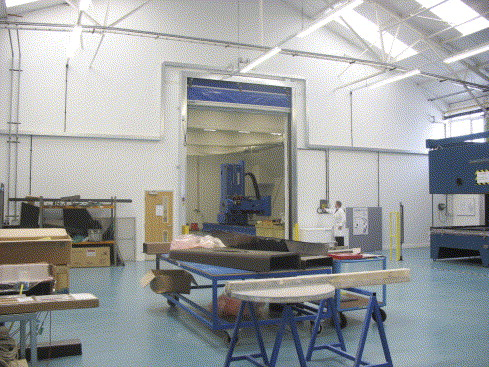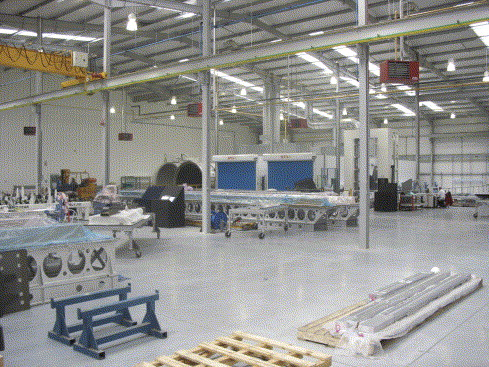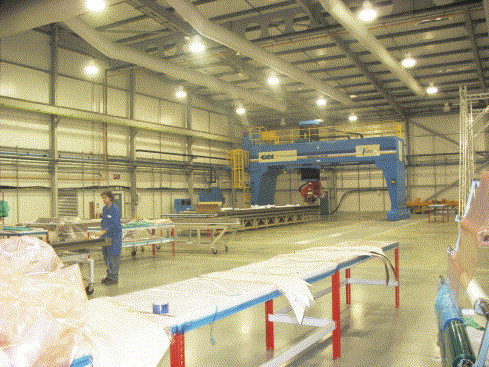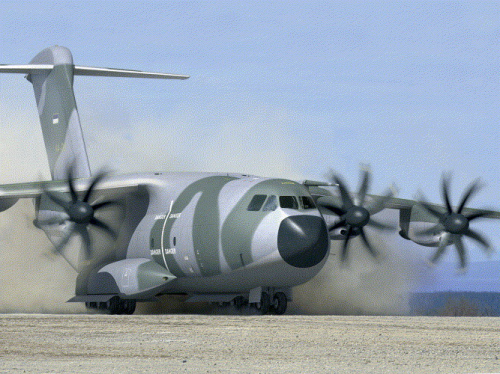



GKN Aerospace continues to invest in composites development and a tangible sign of that is an advanced centre for composites research, development and manufacture at Cowes, Isle of Wight, UK. The purpose-built advanced composites facility at the Osborne Engineering Centre, East Cowes, was commissioned last June and became fully operational in January this year. The new complex comprises a manufacturing unit, currently producing spars for the composite wings of the new European military transport the Airbus A400M, and an adjoining composites research centre, which concentrates on aerospace composites R&D.
The manufacturing unit recently delivered its first spars for the A400M. These thick carbon/epoxy laminate structures mark an evolutionary step in the composites expertise of GKN Aerospace, UK.
“We have been known chiefly for two-dimensional ‘shell’-type structures – control surfaces, nacelles, ducts and the like,” head of technology John Cornforth told Reinforced Plastics during a recent site visit. “Now we're producing components that are far more volumetric, up to 40 mm thick. The A400M spar is well into that spectrum at 20 mm maximum laminate thickness.”
Each wing of the new 136.5 tonne (maximum take-off weight), 42.4 m span military transport is to have a forward and rear spar, each of these being made up of two sections, inner and outer. A complete aircraft spar set consists of eight sections, four each for the port and starboard wings. The longest of these is 14 m and the shortest 5 m. The ‘C’ section span-wise spars are spaced apart with fore-and-aft ribs – some metal, some composite – to form the primary structure that bears the wing loads. Composite wing skins are bolted to this structure to complete the closed-cell wing box.
In order to meet programme needs, early spars have been hand-built. Future spars will be produced in the new ‘factory of the future’ in which light, clean, spacious conditions prevail and automation is taken to a high level. Each spar section is made by laying up unidirectional carbon prepreg material, then hot drape forming the resulting ply stack over a male forming tool. The component then proceeds to an autoclave for a compaction/cure cycle. An acoustic C-scan non-destructive inspection (NDI) follows, after which the component is machined to its final dimensions.
Great care has been taken to ensure dimensional accuracy. For example, the lay-up table for the M Torres gantry-type carbon prepreg tape layer rests on deep concrete foundations to ensure stability and is levelled to an accuracy of some 40 μm. Invar tooling is used for its thermal stability, though less expensive (albeit less durable) composite tooling is being investigated and may provide the optimum solution for the future.
Every step is designed to reduce the manual labour usually associated with composite fabrication. This cost reduction strategy is absolutely essential, Cornforth points out, if manufacturing jobs are to be retained in countries like the UK.
The gantry tape layer operates in 12 axes under CNC control to produce ply stacks fast and repeatably. Laying 300 mm wide tape, it can produce carbon composite components up to 14 m long by 1.5 m wide. Hot drape forming saves the time and labour involved in laying up and compacting a component layer by layer. The flat prepreg form is placed over a forming tool and under a membrane so that vacuum pressure can be exerted. Heating is provided by an overhead solarium. Under appropriate heat and vacuum, the component is rapidly formed to the required shape. According to John Cornforth, the process is highly effective once it has been set up. Achieving a smooth ‘feature-less’ finish on the part requires careful zonal adjustment of parameters, these being established initially using software modelling and tests. The part-cured component is then subjected to a closely controlled cure cycle in an autoclave. GKN Aerospace had to stretch an existing autoclave by inserting a central cylindrical ‘slice,’ thereby lengthening it from 6 m to 16 m.
Like other stages, the ultrasonic C-scan NDI process is automated, through the use of a MIDAS multi-phased array machine. Final machining takes place under CNC control to tight tolerances, secured by using precision fixtures and a working table that is stabilised on concrete foundations.
GKN has been refining the automated production cycle in an ongoing development process that is now nearing completion. Programme manager Clive Sibley says that the manufacturing unit will turn out two or three more full spar sets this year (in addition to the first set previously mentioned), followed by up to a dozen sets next year. The facility will, by next year, be capable of producing 48 sets per year, though actual production will probably be pegged to a rate of three sets a month through 2010. (Some 192 A400Ms have been ordered so far.) Finished spars are delivered to Airbus UK (formerly BAE Systems) at Broughton for integration into complete wings.
Technology development
A significant role for the composites research centre, built alongside the manufacturing unit, is to act as a pre-manufacturing cell, developing and refining the technologies used in parts manufacture.
Some of the technology used has emerged from a number of national and international programmes intended to advance the state of the art in the construction of wings and other aerostructures. For example, the EFFICOMP (Efficient Composite Primary Structure) programme, 50% funded by the UK's Department of Trade and Industry and completed in January this year, was aimed at finding the best material systems for producing various wing parts at affordable cost. The EC-backed Advanced Low Cost Aircraft Structures (ALCAS) R&D programme now in progress takes matters further by validating wing structural technologies that could be applicable to new aircraft such as the Airbus A350. As part of the project's strong focus on reduced-cost carbon composite systems, autoclave-free technologies based on self-heating tooling and vacuum-facilitated processes are being further developed. Some 52 partners from 15 nations are taking part and GKN is producing a front spar assembly 10.5 m long and weighing 100 kg.
These involvements have followed participation in the European project, AWIATOR (Aircraft Wing with Advanced Technology Operation), a four-year pro-gramme due to end next January. This Airbus-coordinated €80 million technology platform, co-financed from the European Union's research budget, has focused on producing wings for future aircraft that are both efficient and silent. GKN Aerospace also participated in the European TANGO project to create lighter aircraft structures.
Involvement in such programmes has helped GKN to further develop and exploit a range of technologies, including resin film infusion (RFI) and resin transfer moulding (RTM). The company's RFI process has been instrumental in winning contracts to supply wing trailing edge components for Airbus aircraft, including the new A380 ‘super jumbo,’ now in its flight test phase. Infused items include A380 trailing edge panels, plus skins and spars for the AWIATOR project. Production of such items is shared between Cowes and a GKN facility in Alabama, USA.
The Composites Research Centre (CRC) at Cowes is well equipped to carry out its manufacturing support and collaborative technology development roles. It has its own pillar design M Torres tape layer and an integrated CNC controlled mandrel system that can lay flat parts 9.5 m long by 2.5 m wide, and curved parts 4 m in diameter and 5 m long. A hot drape forming (HDF) capability includes associated tooling, heating, vacuum and control facilities. A vacuum-assisted programmable curing oven and spray bake booths are also available. An advanced CNC machining centre has 3-axis capability currently, and there are plans to invest in a 5-axis machine before the end of the year. A C-scan tester and other NDI tools are complemented by various tensile and other testers.
An environmentally controlled clean area, refrigerated storage and a well equipped composites laboratory are among the other facilities.
Propulsion
A third role for the advanced composites centre is to help GKN Aerospace to diversify into new areas of flight-critical structure. One sector regarded as promising is aero engines.
“We see this as a growth area,” John Cornforth explains. “Given increased environmental pressures and the continued expansion of air transport, aviation has to further intensify its efforts to reduce fuel burn. We foresee the trend to lighter structures, now well established in airframes, being replicated in engines too. There's much that can be done to lighten the low-pressure (cooler) section of an aero engine.”
The Advisory Council for Aeronautics Research in Europe (ACARE) concurs, having targeted a halving of carbon dioxide emissions and perceived noise by 2020.
“To give any hope of achieving the emissions target, the engine contribution towards overall aircraft fuel burn per passenger-kilometre will have to be reduced by 15-20%,” Cornforth declares. “One major enabler for this is to engineer structures that have higher performance for the same weight. In view of our composites expertise, that's an opportunity for us.”
GKN Aerospace is already active in the engine market, producing nacelles, rings, cases, ducts, nozzles, spinners, guide vanes, disc spacers, acoustic liners and thrust reverser cascades. The company is now expanding into flight critical areas of the engine such as fan blades and fan containment cases (designed to contain the results of any disintegration in a rapidly rotating assembly). Carbon fibre cases, for example, become a highly practical containment system once light carbon fibre blades are used for compressors etc. GKN Aerospace is contracted to US engine prime GE for the development and manufacture of a composite fan containment case for the GenX engine being developed for the Boeing 787.
The company is also participating in the VITAL (Environmentally Friendly Aero Engine) programme, which was launched in 2005. A four-year project, VITAL has €50 million of funding under the European Commission's Sixth Framework Programme (FP6) and involves 53 partners, including eight major European engine manufacturers, one of the biggest of which is Snecma. Its aim is implicit in the title, and there is a particular focus on the low-pressure elements of engines.
From its involvement in VITAL, GKN Aerospace is convinced that by-pass ratios will be pushed still higher, with an accompanying trend to even larger, lower speed fans, which will be quieter in operation.
Airbus and Boeing will rely on new engine technology to meet the stringent targets they have set themselves for future aircraft, in particular the projected replacements for their present top-selling A320 and B737 narrowbodies respectively. Airbus chief executive Gustav Humbert has said that both companies will need an all new engine to be available by about 2013-14, ready to power the new aircraft from the middle of the decade. Work now taking place at the centre of composite excellence at the Osborne site, East Cowes, will help ensure that GKN Aerospace, as a Tier 1 supplier with advanced composites expertise, will be ready to help meet the challenge.
Third-party support
A further role for the Composites Research Centre (CRC) is to provide technology support for other UK companies seeking to develop their composite capabilities. This was a condition behind funding contributions received from both the DTI and the South East England Development Agency. SEEDA encouraged the setting up of the GKN centre as part of its policy to make the Isle of Wight a centre of composites excellence. The Cowes complex is one of four UK centres within the National Composites Network (NCN). The others are at Manchester (the North West Composites Centre), Filton near Bristol (Airbus Composites Development Centre) and Port Talbot in Wales (NDT Validation Centre).






